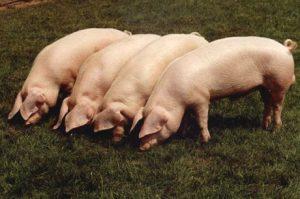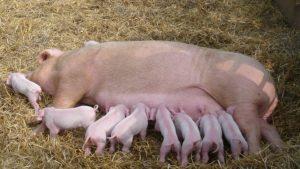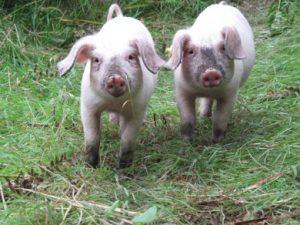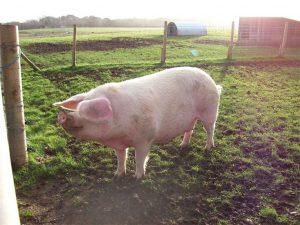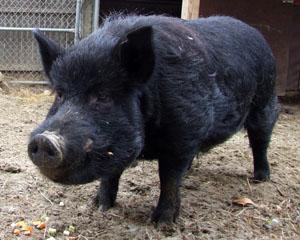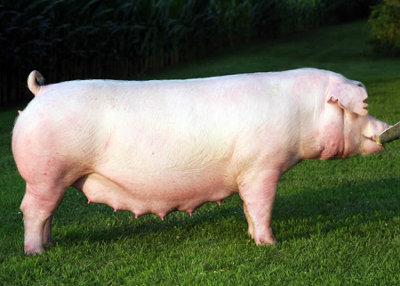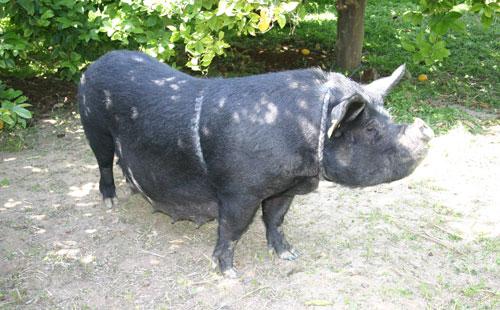British Lop
The British Lop Pig is a large variety of endangered, domesticated swine that was initially reared for its meat. This pigs are marked by their characteristic large ears that hang over their faces, almost covering the eyes, and it is because of these lop ears that the breed got its current name.
These animals are known for their low-fat and less greasy meat, which is equally tasteful and savory. However, the population of the breed is going down quickly, so much so that the RBST (Rare Breeds Survival Trust) has enlisted them under the ‘Endangered’ category.
| Also Known As | British Lop-eared Pig |
| Physical Characteristics | The stature is large, but the shape of the body is long and lean; the males are quite larger than the females; similar in appearance to the Landrace and the Welsh pigs, but has a much deeper body |
| Personality Traits | Peaceful, humble, adaptable |
| Size | Large |
| Coat Hair | Short |
| Skin Color | White to pinkish white |
| Tail | Twisted |
| Uses | Meat (pork/bacon) production |
| Weight (size) | Boar: 350 kg (average) Sow: 300 kg (average) |
| Popular Traits | Extremely hardy; docile-natured; not prone to becoming overweight; farming is easy; good forager |
| Availability | Rare |
| Conservation Status | Endangered |
| Litter Size | 12-14 |
| Diet | Omnivorous |
| Country of Origin | United Kingdom |
| Societies & Associations | Breed Preservation and Programs |
History and Development
This breed is a West Country breed that originated around either side of the Cornwall/Devon borders known as the ‘Tavistock’. Down the decades of its breed-history, beginning at the prime of the twentieth century, the breed continued to exist as an undiscovered local breed, and never caught the sight of the farmers outside its territory.
The local breeders never felt the need to go beyond its native territory and advertize the breed, since they were in high demand already within their own realms. The locality also suited them well.
In 1920, the breed society was formed for the very first time, under the name of the National Long White Lop- Eared Pig Society.
In the 1960s, however, the breed came to be known as the ‘British Lop’, and the name of its society too changed to the British Lop Pig Society. At present, it is thought that, this breed was developed by crossing several local lop-eared English breeds. They might be related to the Welsh and the Landrace breeds of Scandinavia, or even the French Normande – the breeds that are found around the north-western fringes of Europe
Farming & Meat (Pork) Production
British Lops yield lean meat. They do not need much care to be reared or farmed. Unlike a few other rare pig breeds, these swine are nor prone to developing excessive body fat, even if managed poorly.
The bacon, ham and pork derived from a well-developed British Lop is a product with a high quality attracting niche market opportunities.
Not just that, the Lop grows slowly, which means, it gives a tastier product. Above all, this breed is docile and easily manageable.
The litter size is big, and the female British Lops make excellent mothers. The piglets attain the age of slaughter within 160-170 days and are ready for sale in the market. At this time, they can yield up to 70-75 kg of meat.
What do they Eat
These pigs are good foragers and are excellent in grazing. The breed is omnivorous by dietary habit, and is an efficient convertor of low quality feed.
Interesting Facts
- While discussing the breed’s rarity, English celebrity chef, television personality, writer and businesswoman Clarissa Dickson Wright once commented that “The British Lop is rarer than the Giant Panda.”
- Prior to the 1960s, the British Lop was known in a long, self-describing name – ‘the National Long White Lop Eared breed’.
- Some breeders call the breed as the ‘Cornish Lop’ since it is originally based in the Westcountry.
- At present, there are only 200 registered breeding sows left in the United Kingdom.


